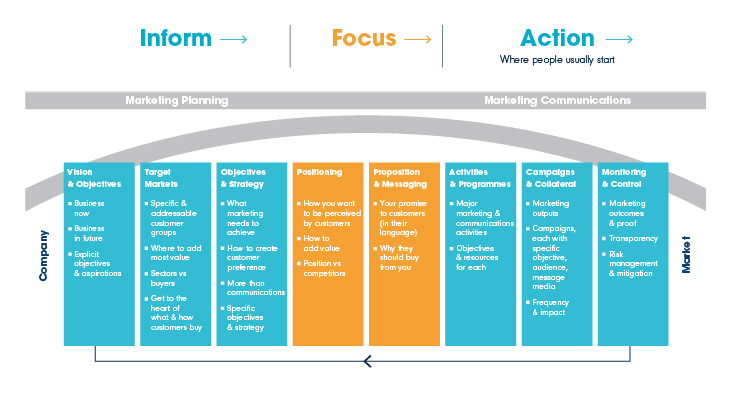Marketing Planning | 10 min. read
Campaign planning. How it works, and how to get it right for your business
Written by Nik Stapleton, 08.09.2022

When a marketing professional gets asked what they do for a living, it’s often the elements of campaign planning they reach for by way of an explanation.
“Oh, you know, I work out the best way to get the company’s message across based on what customers respond to and what websites and magazines they read, then organise all the adverts you see around – that sort of thing…”
There’s no doubt campaign planning is the most accessible part of what we do, from a layman’s point of view at least.
A word to the unwary, though [and one we find ourselves repeating again and again]: Campaign planning can only begin once the marketing planning process has delivered clear, agreed marketing objectives, that cascade from equally clear business objectives.

Developing a marketing strategy is essential before you begin your campaign planning.
If you don’t have a marketing plan in place, you need one. Take a look at our article – why is marketing planning important? There are plenty of resources to further your knowledge from organisations like the Chartered Institute of Marketing.
For now, though, we’re assuming you’ve followed a model like SOSTAC® or another planning framework to move you smoothly through the Objectives and Strategy parts of the process to a point where you’re ready to start thinking about Tactics and Action. In other words, planning your campaign.
So what is campaign planning?
As so often happens in the marketing world, the precise definition of campaign planning has got muddied over the years as less than professional practitioners play fast and loose with terminology.
So before we look at its various disciplines and processes, it’s worth setting out precisely what we mean when we use the phrase ‘campaign planning’.
Ready?
Back in the day, it was standard practice for brands to plan their communications through several distinct channels: advertising, PR, POS, direct mail and the rest. Often, the strategies for each would be handled by separate teams, separate departments and even separate agencies.
In those pre-digital times, B2C marketers placed mass media like TV advertising at the heart of their planning because of its sheer reach, building every other element off it. Easy, right?
Then things got complicated. Commercial TV went from two or three channels to hundreds. And of course, the internet happened.
The mass audience for B2C, and to a lesser extent, B2B communications became dispersed and much harder to target, and with the rise of online channels, control of information passed from the advertiser to the customer.
At the same time, purse strings got tighter [don’t they always?] and boards started asking exactly what they were getting in return for their marketing spend. So, the key question for marketers was no longer: “How are we going to spend our advertising budget.”, but, “How should we spend all the money used in our marketing communications more effectively?”
That meant examining and understanding the specific roles various channels had to play – while at the same time, working together to provide a ‘Multiplier Effect’ that reinforced the overall message.
In essence, then, campaign planning is the discipline of combining channels, messages, assets and budgets in such a way that they are wholly integrated. Not separate strands in a planning document, but a tightly woven strategy pointing towards clear communications objectives.
So, let’s have a look at the questions you should be asking when you start developing your plan:
- What is your campaign objective[s]?
- Targeting: Who’s your target audience?
- What message do you need to convey, and why should they believe you?
- What are the most effective channels to reach them?
- What creative approach and techniques do you use to deliver standout?
- What will the campaign plan cost, and is it within your budget?
- How will you know if the plan has worked, and have you identified metrics?
Establishing your campaign planning objective[s]
First things first. What is your campaign plan setting out to achieve?
Well, remember we said earlier on about how essential it was to have your marketing objectives? Your campaign plan is where you pull them through into your communications.
And to do that, you need to square your marketing objectives with your campaign objectives.
So if your marketing planning objective is to ‘Justify a higher price point to increase profit by 15% in Q1, year 2’, the way you do it [your campaign planning objective] could be to ‘Increase awareness and prestige appeal of the brand to market segment ‘A’ by Q2, year 1.’
See the relationship?
Objectives can be long term – moving the needle of brand perception over years – or short term, such as a new product launch. But long or short, every campaign plan must have a way of measuring performance against the ultimate objective – most often, a financial one.
In the digital age, of course, methods for measuring campaign performance have become increasingly granular. In part because the personalised, ultra-targeted nature of the internet gives marketers such a wealth of valuable metrics.
So what exactly should you measure to get a steer on the success of your marketing campaign?
Advice on this differs, as do circumstances, but in typical digital campaign planning, you can expect to see at least three common goals for measurement:
Traffic building goals can be expressed as visits or sales. For example, ‘Achieve 100,000 unique visitors, or 200,000 visitor sessions, in a year’ or, ‘Gain a 4.5% increase in sales revenue from product ‘A’ within three months’.
Conversion or interaction goals are a measure of how effective your online messaging is. They measure things like how many people sign up for a new online service or what proportion of new visitors go on to make an online purchase.
Third-party site and branding goals measure reach, influence and engagements with your campaign on third-party sites, news sites and social networks. They are a good indication of the ‘shareability’ that is so crucial to success in so much internet marketing.
Targeting: Who’s the audience?
The question ‘Who are we talking to?’ [often referred to as part of ‘segmentation’] is covered in the most basic marketing 101 texts. Of course it is. Who doesn’t know it’s vital to know your audience? You’d be surprised.
Like everything else in recent years, however, the answer has become more complicated as online algorithms and AI systems crunch our behaviour and preferences.
Whereas in the past, they would most often rely on classic ABC1 customer demographics, today’s campaign planners are drawing on new, more nuanced ways of segmenting their audience.
Many of these rely on past and current patterns of behaviour rather than social class indicators. As such, they tend to be more fluid than simple demographic classifications, and better suited in particular to defining B2B audiences.
There are several key targeting variables you can consider when you’re working out exactly who to aim your B2B campaign at. These include:
Their relationship with your company: Are they new contacts? Existing customers? Or have they lapsed in recent years?
Their ‘firmagraphic’: What sector does their business operate in? How big is the company? Who are the most influential people in the decision-making unit?
Their attitudinal segmentation: How do they view risk and value? Are they early adopters, followers or brand-loyal buyers?
Their value: What have they spent in the past? Are they likely to buy consistently in the future?
Their behaviour: What sort of things do they search for in your sector? Do they respond to any particular offers or promotions, or do they seem more open to one channel above all the others you use?
Any or all of these factors can give you valuable insight when you’re developing your campaign plan. Especially when it comes to the media choices you make and the tone of voice you use in your creative executions to connect and build empathy with your audience.
What do you say? Finding the right message[s] for your campaign plan
Clarity of communication in your campaign comes with clarity in your understanding of what you want to get across to your customer. Marketers commonly talk about this as finding the ‘value proposition’.
It’s not enough to just plant your flag on the high ground of ‘the best’, ‘the cheapest’ or ‘the highest quality’, though many advertisers do. Bald, ‘me too’ claims like this seldom engage customers, much less give them the impression you can solve their business problem.
So how do you make sure you’re saying the right thing to the right people in the right way?
Much of the best practice on effective messaging was perfected by direct marketers in years gone by. And a good deal of their advice is still relevant in the digital age, particularly that offered by DM expert Drayton Bird.
Among the things he recommends marketers consider when ‘finding an angle’ for their B2B product or service are:
What needs does it fulfil for them? Does it save them money? Make them money? Give them more time in their day?
Is there an emotional aspect to what you’re offering? Can it help them feel more secure in their job [particularly these days]? Does it have the potential to earn them the respect of their peers, or their board?
Remember, while B2B marketing inhabits a mostly commercial customer environment, it can often be messaging that appeals to the human instincts of decision-makers that hits home most effectively.
Delivering your message
The next step in campaign planning is to turn your core message into an eye-catching, persuasive series of creative executions that will stop your audience in their tracks.
This stage of the proceedings is often passed over to a creative agency to ‘work their magic’ on your carefully thought out brief.
But while there’s a place for creative, right-brain thinking in coming up with the images and ideas that make your message stand out, it also comes with an element of risk. Agencies and in-house teams can sometimes let their creative instincts override their obligation to deliver a commercial proposition. And creative execution is more open to a subjective opinion than any other part of the campaign planning process.
We’re not saying don’t get creative specialists involved, of course. Why would we? But having an objective method of assessing their work can be invaluable at this stage.
One of the most established is the AIDA principle, standing for Attention, Interest, Desire and Action.
It’s an easy, shorthand way to judge whether or not the work will attract your audience in the first place. How well it engages them once it’s drawn the eye. If that engagement is likely to translate into a need to buy or find out more. And whether it contains a clear call to action.
If you want to go the extra mile, you can also do some concept testing with a sample of your prospective customers before you put your creative work into production.
Remember as well, a large part of delivering a compelling message depends on the assets you have at your disposable. High-quality photography, illustration, CGI, film and sound design have a big part to play in creating a polished, professional image for your organisation.

Our animated Gif banner for Boughey Distribution, showing how we create high-end imagery. The final image underpinned the core message of ‘A safe pair hands’ in an eye-catching and compelling way.
Not only do such assets project a positive impression of your business. Many of them – videos, for instance – can also help increase the visibility of your campaign online by attracting the algorithms programmed to look for the ‘rich’ content staples that make a website more compelling for users.
When we were approached by Bangor University to create a campaign attracting undergraduate students to their School of Natural Sciences, video was a core asset from the outset.
Created around the theme ‘Go on to Make a Difference’, it featured Bangor students talking about their passion for the environment and their determination to make a difference equipped with the skills and qualifications Bangor University gave them. A persuasive and emotional ‘sell’ that would have been hard to achieve in any other medium.
Costing your campaign plan
No plan is complete, of course, without a thorough breakdown of what needs to be spent to deliver its objective.
This is a matter of answering two seemingly simple questions. How much do I need to spend to achieve the marketing objective[s]? And what is the most efficient way to spend it with the channels available to me?
Although they’re simple questions, the sheer choice of media options available to the campaign planner today means budgeting is a nuanced and sometimes complex discipline.
Various approaches are outlined in the marketing textbooks, among them the Percentage of Sales method, in which spend is allocated based on anticipated sales; Competitive Parity, based on the estimated spend of competitor brands; and the Objective Task Method, combining the total cost of every campaign element.
Likewise, there is no shortage of advice on which of the dozens of available channels marketers should be spending their money on. The media landscape now includes everything from TV and radio advertising, trade press titles and direct marketing, to PR, email, SEO, social media and other forms of digital marketing, events, podcasts, webinars and more – not all, of course, appropriate for B2B marketing.
Budget and media planning are dedicated disciplines in their own right, with enough in the way of theory, methods and processes to fill an entire article. We haven’t got the room to unpack them all here. But we’ll always be happy to offer our advice on these, and any other aspect of the marketing process you need help with.
This is the way we approach campaign planning – the Intermedia bridge
By approaching your campaign plan as a natural progression of your marketing plan, you can take your proposals to your board [and, just as importantly, the finance department], confident in the knowledge you can deliver the objectives you’ve promised.

The Intermedia bridge model. How campaign planning grows out of marketing planning.
As you can see from the Intermedia bridge model we apply, marketing activity programmes, campaigns and collateral are never developed independently of an overall strategic view. They are the product of a proven process, tested and refined over the course of hundreds of successful campaigns.
Of course, while this proven framework directs our thinking, the proposals it helps us produce are based entirely on the unique challenges and commercial priorities of each client.
Need help with aligning marketing objectives with campaign planning?
There are so many elements to consider and get right in campaign planning, it’s easy to see why there’s so much confusion, budget waste, and lacklustre results.
So, if you need a robust campaign plan that will keep your board onside, or just need advice on a specific planning task, we’re here to help. Talk to Intermedia.
Originally published September 8, 2022 16:05pm, updated April 19, 2023
